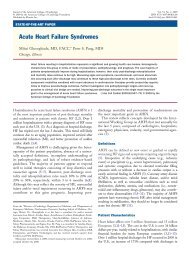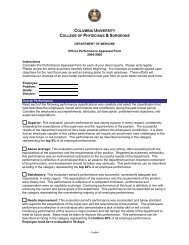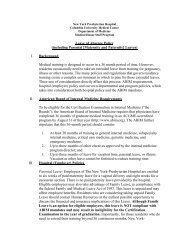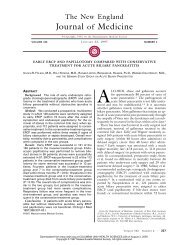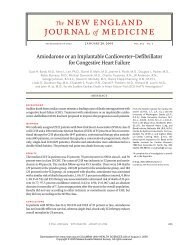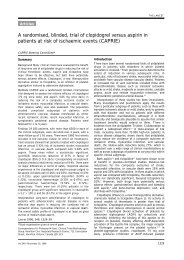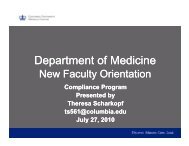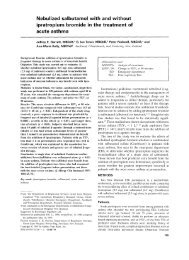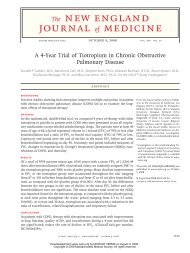Acute Hemodynamic Effects of Octreotide and Terlipressin in ...
Acute Hemodynamic Effects of Octreotide and Terlipressin in ...
Acute Hemodynamic Effects of Octreotide and Terlipressin in ...
Create successful ePaper yourself
Turn your PDF publications into a flip-book with our unique Google optimized e-Paper software.
American Journal <strong>of</strong> Gastroenterology ISSN 0002-9270<br />
C○ 2005 by Am. Coll. <strong>of</strong> Gastroenterology<br />
doi: 10.1111/j.1572-0241.2005.41381.x<br />
Published by Blackwell Publish<strong>in</strong>g<br />
<strong>Acute</strong> <strong>Hemodynamic</strong> <strong>Effects</strong> <strong>of</strong> <strong>Octreotide</strong> <strong>and</strong> <strong>Terlipress<strong>in</strong></strong><br />
<strong>in</strong> Patients with Cirrhosis: A R<strong>and</strong>omized Comparison<br />
Soon Koo Baik, M.D., Phil Ho Jeong, M.D., Sang Won Ji, M.D., Byung Su Yoo, M.D., Hyun Soo Kim, M.D.,<br />
Dong Ki Lee, M.D., Sang Ok Kwon, M.D., Young Ju Kim, M.D., Joong Wha Park, M.D., Sei J<strong>in</strong> Chang, Ph.D.,<br />
<strong>and</strong> Samuel S. Lee, M.D.<br />
Department <strong>of</strong> Internal Medic<strong>in</strong>e; Department <strong>of</strong> Radiology; Department <strong>of</strong> Preventive Medic<strong>in</strong>e <strong>and</strong> Institute<br />
<strong>of</strong> Occupational Medic<strong>in</strong>e, Yonsei University Wonju College <strong>of</strong> Medic<strong>in</strong>e, Wonju, South Korea; <strong>and</strong> Liver Unit,<br />
University <strong>of</strong> Calgary, Calgary, Canada<br />
BACKGROUND:<br />
AIM:<br />
PATIENTS:<br />
METHODS:<br />
RESULTS:<br />
CONCLUSIONS:<br />
<strong>Octreotide</strong> <strong>and</strong> terlipress<strong>in</strong> are widely used <strong>in</strong> acute variceal hemorrhage to reduce the bleed<strong>in</strong>g<br />
rate. They purportedly act by mesenteric arterial vasoconstriction, thus reduc<strong>in</strong>g portal venous flow<br />
(PVF) <strong>and</strong> portal pressure. Little is known about the immediate-early hemodynamic effects <strong>of</strong> these<br />
drugs.<br />
To compare the acute hemodynamic effects <strong>of</strong> octreotide <strong>and</strong> terlipress<strong>in</strong> <strong>in</strong> patients with cirrhosis.<br />
Forty-two cirrhotic patients with a history <strong>of</strong> variceal bleed<strong>in</strong>g were r<strong>and</strong>omized to receive either<br />
octreotide 100 µg <strong>in</strong>travenous bolus followed by a cont<strong>in</strong>uous <strong>in</strong>fusion at 250 µg/h (n = 21), or<br />
terlipress<strong>in</strong> 2 mg <strong>in</strong>travenous bolus (n = 21).<br />
Mean arterial pressure (MAP), heart rate (HR), hepatic venous pressure gradient (HVPG), <strong>and</strong> PVF,<br />
assessed by duplex Doppler ultrasonography, were measured before <strong>and</strong> at 1, 5, 10, 15, 20, <strong>and</strong> 25<br />
m<strong>in</strong> after the start <strong>of</strong> drug adm<strong>in</strong>istration.<br />
<strong>Octreotide</strong> markedly decreased HVPG (−44.5 ± 17.8%) <strong>and</strong> PVF (−30.6 ± 13.6%) compared to the<br />
basel<strong>in</strong>e at 1 m<strong>in</strong> (p < 0.05). Thereafter, both variables rapidly returned toward the basel<strong>in</strong>e, <strong>and</strong> by<br />
5 m<strong>in</strong>, no significant differences <strong>in</strong> HVPG (−7.1 ± 28.9%) <strong>and</strong> PVF (10.2 ± 26.2%) were noted. A<br />
similar transient effect on MAP <strong>and</strong> HR was observed. <strong>Terlipress<strong>in</strong></strong> significantly decreased HVPG<br />
(−18.3 ± 11.9%) <strong>and</strong> PVF (−32.6 ± 10.5%) at 1 m<strong>in</strong> (p < 0.05) <strong>and</strong> susta<strong>in</strong>ed these effects at all<br />
time po<strong>in</strong>ts. The effects on arterial pressure <strong>and</strong> HR were also susta<strong>in</strong>ed.<br />
<strong>Octreotide</strong> only transiently reduced portal pressure <strong>and</strong> flow, whereas the effects <strong>of</strong> terlipress<strong>in</strong><br />
were susta<strong>in</strong>ed. These results suggest that terlipress<strong>in</strong> may have more susta<strong>in</strong>ed hemodynamic<br />
effects <strong>in</strong> patients with bleed<strong>in</strong>g varices.<br />
(Am J Gastroenterol 2005;100:631–635)<br />
INTRODUCTION<br />
<strong>Octreotide</strong> <strong>and</strong> terlipress<strong>in</strong> are probably the two most commonly<br />
used drugs worldwide to reduce the rate <strong>of</strong> acute<br />
bleed<strong>in</strong>g from gastroesophageal varices <strong>in</strong> patients with<br />
portal hypertension (1–5). It is believed that both drugs<br />
act as mesenteric vasoconstrictors, thus reduc<strong>in</strong>g portal venous<br />
flow (PVF) <strong>and</strong> pressure (2, 6, 7). <strong>Octreotide</strong> is a<br />
synthetic octapeptide with pharmacologic actions similar<br />
to that <strong>of</strong> somatostat<strong>in</strong>. However, the therapeutic effect <strong>of</strong><br />
octreotide on the portal <strong>and</strong> systemic hemodynamics <strong>in</strong><br />
patients with liver cirrhosis is controversial. Some studies<br />
report favorable effects on portal hemodynamics with octreotide<br />
<strong>in</strong>fusion, whereas others have failed to show any<br />
beneficial effects (8–12). <strong>Terlipress<strong>in</strong></strong> or triglycyl lys<strong>in</strong>e vasopress<strong>in</strong><br />
is a synthetic long-act<strong>in</strong>g analogue <strong>of</strong> vasopress<strong>in</strong>.<br />
It has been shown to <strong>in</strong>duce systemic <strong>and</strong> mesenteric vasoconstriction,<br />
at least when exam<strong>in</strong>ed between 30–240 m<strong>in</strong> after<br />
adm<strong>in</strong>istration (13–17).<br />
To produce effective tamponade <strong>of</strong> actively bleed<strong>in</strong>g<br />
varices, the ideal drug therapy should quickly reduce PVF<br />
<strong>and</strong> pressure, preferably with<strong>in</strong> seconds to m<strong>in</strong>utes. In<br />
view <strong>of</strong> this, it is somewhat surpris<strong>in</strong>g that virtually all<br />
previous hemodynamic studies <strong>of</strong> both drugs have exam<strong>in</strong>ed<br />
their effects at 30–240 m<strong>in</strong> after the start <strong>of</strong> adm<strong>in</strong>istration.<br />
To date, there have been almost no studies<br />
focused on the immediate-early effects between 1–30<br />
m<strong>in</strong>. Therefore, the aim <strong>of</strong> the present study was to compare<br />
the immediate-early hemodynamic effects <strong>of</strong> st<strong>and</strong>ard<br />
doses <strong>of</strong> both octreotide <strong>and</strong> terlipress<strong>in</strong> on PVF <strong>and</strong><br />
pressure <strong>in</strong> cirrhotic patients with a history <strong>of</strong> variceal<br />
bleed<strong>in</strong>g.<br />
631
632 Baik et al.<br />
Table 1. Cl<strong>in</strong>ical Characteristics <strong>of</strong> the Subjects<br />
<strong>Octreotide</strong> (n = 21) <strong>Terlipress<strong>in</strong></strong> (n = 21) p<br />
Age (years) 47.8 ± 7.4 49.5 ± 10.9 NS<br />
Sex (male/female) 20/1 19/2 NS<br />
Child-Pugh class (A/B/C) 9/11/1 9/8/4 NS<br />
Child-Pugh score 6.9 ± 1.3 7.6 ± 1.9 NS<br />
Etiology (alcohol/viral/comb<strong>in</strong>ed) 15/2/4 15/3/3 NS<br />
HVPG at basel<strong>in</strong>e (mmHg) 16.1 ± 5.2 17.6 ± 4.1 NS<br />
PVF at basel<strong>in</strong>e (ml/mm) 683 ± 456 761 ± 409 NS<br />
MAP at basel<strong>in</strong>e (mmHg) 88.8 ± 13.9 86.3 ± 14.4 NS<br />
HR at basel<strong>in</strong>e (beats/m<strong>in</strong>) 70.0 ± 9.8 69.2 ± 12.7 NS<br />
HVPG, hepatic venous pressure gradient; PVF, portal venous flow; MAP, mean arterial pressure; HR, heart rate; NS, not significant.<br />
PATIENTS AND METHODS<br />
Study Cohort<br />
The study <strong>in</strong>cluded 42 cirrhotic patients with portal hypertension<br />
who had been hospitalized for acute variceal bleed<strong>in</strong>g<br />
from December 2002 to January 2004. All the bleed<strong>in</strong>g<br />
episodes <strong>in</strong> patients were managed by endoscopic variceal<br />
ligation <strong>and</strong> patients did not receive octreotide or terlipress<strong>in</strong><br />
dur<strong>in</strong>g the acute bleed<strong>in</strong>g episode. The etiology <strong>of</strong> cirrhosis<br />
was alcohol-<strong>in</strong>duced <strong>in</strong> 30 patients, chronic viral hepatitis <strong>in</strong> 5<br />
patients, <strong>and</strong> both alcohol <strong>and</strong> viral hepatitis <strong>in</strong> 7 patients. The<br />
mean age <strong>of</strong> patients was 48.7 ± 9.3 yr, compris<strong>in</strong>g 39 males<br />
<strong>and</strong> 3 females (Table 1). Patients with severe liver failure<br />
(serum bilirub<strong>in</strong> level >85 µmol/L), hepatic encephalopathy,<br />
severe arterial hypotension (mean arterial pressure (MAP) <<br />
60 mmHg), hepatorenal syndrome, <strong>and</strong> ultrasonographic data<br />
suggest<strong>in</strong>g a hepatocellular carc<strong>in</strong>oma <strong>and</strong> portal ve<strong>in</strong> thrombosis<br />
were excluded from the study. No patients were tak<strong>in</strong>g<br />
drugs affect<strong>in</strong>g hemodynamics such as β-blocker. The study<br />
was conducted accord<strong>in</strong>g to the pr<strong>in</strong>ciples <strong>of</strong> the Declaration<br />
<strong>of</strong> Hels<strong>in</strong>ki. The Ethics Committee <strong>of</strong> the Wonju College <strong>of</strong><br />
Medic<strong>in</strong>e university hospital approved the protocol, <strong>and</strong> the<br />
patients gave written <strong>in</strong>formed consent.<br />
Sample size calculations were performed presum<strong>in</strong>g a<br />
mean reduction <strong>in</strong> hepatic venous pressure gradient (HVPG)<br />
from 5% to 50% from basel<strong>in</strong>e <strong>and</strong> a 20% SD <strong>of</strong> HVPG reduction<br />
<strong>in</strong> both groups. To obta<strong>in</strong> a probability <strong>of</strong> obta<strong>in</strong><strong>in</strong>g<br />
an α-error = 0.05 <strong>and</strong> β-error = 0.10, 21 patients <strong>in</strong> each arm<br />
were required. The r<strong>and</strong>omization was performed as follows:<br />
In total, 42 sets <strong>of</strong> the study medication were prepared: 21<br />
sets conta<strong>in</strong><strong>in</strong>g octreotide (S<strong>and</strong>ostat<strong>in</strong> R ,Novartis Pharma<br />
AG, Basle, Switzerl<strong>and</strong>) <strong>and</strong> 21 sets conta<strong>in</strong><strong>in</strong>g terlipress<strong>in</strong><br />
(Glypress<strong>in</strong> R ,Ferr<strong>in</strong>g GmbH, Kiel, Germany). These sets<br />
were r<strong>and</strong>omly numbered from 1 to 42 <strong>and</strong> prepared with<br />
the same <strong>in</strong> appearance. Patients were numbered chronologically<br />
from 1 to 42, accord<strong>in</strong>g to the date <strong>of</strong> the r<strong>and</strong>omization,<br />
<strong>and</strong> the correspond<strong>in</strong>g set <strong>of</strong> the study medication was<br />
assigned.<br />
<strong>Hemodynamic</strong> Measurements<br />
<strong>Hemodynamic</strong> studies were performed 7 to 10 days after admission,<br />
when the gastro<strong>in</strong>test<strong>in</strong>al bleed<strong>in</strong>g had ceased <strong>and</strong><br />
the hemodynamic conditions had stabilized. The right hepatic<br />
ve<strong>in</strong> was catheterized percutaneously through the femoral<br />
ve<strong>in</strong>, <strong>and</strong> the pressure <strong>in</strong> both the wedged <strong>and</strong> the free position<br />
was recorded us<strong>in</strong>g a7Fr.balloon-tipped catheter<br />
(Arrow Deutschl<strong>and</strong> GmbH, Postfach Erd<strong>in</strong>g, Germany). The<br />
portal pressure was estimated from the HVPG, which was<br />
determ<strong>in</strong>ed by subtract<strong>in</strong>g the free hepatic venous pressure<br />
from the wedged hepatic venous pressure (8, 18, 19). The<br />
PVF was evaluated by Doppler ultrasonography (3.5 MHz<br />
convex probe, Aloka, Tokyo, Japan). Portal venous velocity<br />
<strong>and</strong> the cross-sectional area <strong>of</strong> the portal ve<strong>in</strong> were estimated<br />
from a subcostal scan at its cross<strong>in</strong>g po<strong>in</strong>t with the hepatic<br />
artery. When the sample po<strong>in</strong>t was adjusted to the center<br />
<strong>of</strong> the portal ve<strong>in</strong>, the portal venous velocity was recorded<br />
dur<strong>in</strong>g a quiet suspended expiration <strong>and</strong> was averaged over a<br />
few seconds. The PVF was determ<strong>in</strong>ed by the formula: crosssectional<br />
area × mean velocity × 60 (20). The coefficient <strong>of</strong><br />
variation for the PVF measurements with this method <strong>in</strong> our<br />
center is 3% (21). The MAP was measured non<strong>in</strong>vasively<br />
with an automated sphygmomanometer (Hewlett-Packard M<br />
1205A; Palo Alto, CA). The heart rate (HR) was derived<br />
from cont<strong>in</strong>uous electrocardiogram monitor<strong>in</strong>g. The HVPG,<br />
PVF, MAP, <strong>and</strong> HR were measured before <strong>and</strong> at 1, 5, 10, 15,<br />
20, <strong>and</strong> 25 m<strong>in</strong> after a 100 µg octreotide <strong>in</strong>travenous bolus,<br />
followed by cont<strong>in</strong>uous <strong>in</strong>fusion <strong>of</strong> 250 µg/h (n = 21), or a<br />
2mgterlipress<strong>in</strong> <strong>in</strong>travenous bolus (n = 21). No <strong>in</strong>formation<br />
for adm<strong>in</strong>istrated drugs was provided to <strong>in</strong>vestigators by the<br />
end <strong>of</strong> study.<br />
Statistical Analysis<br />
All data are expressed as means ± SD. A repeated-measures<br />
analysis <strong>of</strong> variance (ANOVA) was used to <strong>in</strong>vestigate the<br />
changes <strong>in</strong> the HVPG <strong>and</strong> PVF after octreotide or terlipress<strong>in</strong><br />
adm<strong>in</strong>istration. Unpaired Student’s t-test <strong>and</strong> χ 2 tests were<br />
used for statistical analyses <strong>of</strong> the differences between the octreotide<br />
<strong>and</strong> terlipress<strong>in</strong> group. A p-value < 0.05 was considered<br />
significant. All statistics were analyzed us<strong>in</strong>g the SPSS<br />
version 11.0 s<strong>of</strong>tware (SPSS Inc., Chicago, IL).<br />
RESULTS<br />
There were no significant basel<strong>in</strong>e differences between<br />
the octreotide <strong>and</strong> terlipress<strong>in</strong> groups <strong>in</strong> any variable<br />
(Table 1).
<strong>Octreotide</strong> versus <strong>Terlipress<strong>in</strong></strong> <strong>in</strong> <strong>Hemodynamic</strong>s 633<br />
<strong>Hemodynamic</strong> Responses with <strong>Terlipress<strong>in</strong></strong><br />
<strong>Terlipress<strong>in</strong></strong> 2 mg bolus <strong>in</strong>duced a significant decrease both<br />
<strong>in</strong> HVPG <strong>and</strong> PVF (−18.3 ± 11.9%, −32.6 ± 10.5%, respectively,<br />
p < 0.05 vs basel<strong>in</strong>e) at 1 m<strong>in</strong>, <strong>and</strong> these changes<br />
were susta<strong>in</strong>ed at all time po<strong>in</strong>ts measured (Fig. 2A). MAP<br />
<strong>in</strong>creased at 1 m<strong>in</strong> after the terlipress<strong>in</strong> adm<strong>in</strong>istration (from<br />
86.3 ± 14.4 mmHg to 101.2 ± 16.5 mmHg, 17.5 ± 8.5%,<br />
p < 0.05), whereas HR decreased (from 69.2 ± 12.7<br />
beats/m<strong>in</strong> to 59.6 ± 10.6 beats/m<strong>in</strong>, −13.3 ± 9.1%,<br />
p < 0.05), <strong>and</strong> these changes also were susta<strong>in</strong>ed<br />
(Fig. 2B).<br />
To compare the portal-hypotensive effects <strong>of</strong> octreotide<br />
<strong>and</strong> terlipress<strong>in</strong> <strong>in</strong> another manner, we calculated the area<br />
under the curve for the HVPG effects. The areas were 174.5<br />
for octreotide <strong>and</strong> 837.9 for terlipress<strong>in</strong>. Consequently, the<br />
ratio <strong>of</strong> octreotide to terlipress<strong>in</strong> was 1:4.8 <strong>in</strong> area under the<br />
curve, confirm<strong>in</strong>g the greater magnitude <strong>of</strong> terlipress<strong>in</strong> effect<br />
on portal pressure.<br />
Figure 1. <strong>Effects</strong> <strong>of</strong> octreotide (100 µg bolus followed by cont<strong>in</strong>uous<br />
<strong>in</strong>fusion <strong>of</strong> 250 µg/hr) on (A) hepatic venous pressure gradient<br />
(HVPG), portal venous flow (PVF) <strong>and</strong> (B) mean arterial<br />
pressure (MAP), heart rate (HR). Data are shown as percentage<br />
change from basel<strong>in</strong>e. <strong>Octreotide</strong> significantly decreased HVPG<br />
<strong>and</strong> PVF at 1 m<strong>in</strong> <strong>of</strong> its adm<strong>in</strong>istration. However, HVPG <strong>and</strong> PVF<br />
rapidly returned toward the basel<strong>in</strong>e, <strong>and</strong> at 5 m<strong>in</strong>, no significant<br />
difference versus the basel<strong>in</strong>e were noted. Changes <strong>in</strong> MAP were<br />
significant at 1 <strong>and</strong> 5 m<strong>in</strong>, <strong>and</strong> significant change <strong>in</strong> HR was at<br />
1 m<strong>in</strong>.<br />
<strong>Hemodynamic</strong> Responses with <strong>Octreotide</strong><br />
The 100 µg octreotide bolus, followed by cont<strong>in</strong>uous <strong>in</strong>fusion<br />
<strong>of</strong> 250 µ/h significantly decreased both HVPG (from<br />
16.1 ± 5.2 mmHg to 9.1 ± 4.5 mmHg, −44.5 ± 17.8%,<br />
p < 0.05 vs basel<strong>in</strong>e), <strong>and</strong> PVF (from 683 ± 456 ml/m<strong>in</strong> to<br />
446 ± 264 ml/m<strong>in</strong>, −30.6 ± 13.6%, p < 0.05 vs basel<strong>in</strong>e) at<br />
1 m<strong>in</strong> (Fig. 1A). However, HVPG <strong>and</strong> PVF rapidly returned<br />
toward the basel<strong>in</strong>e, <strong>and</strong> at 5 m<strong>in</strong>, no significant difference<br />
versus the basel<strong>in</strong>e were noted (−7.1 ± 28.9%, 10.2 ± 26.2,<br />
respectively, p > 0.05). A significant <strong>in</strong>crease <strong>in</strong> MAP (from<br />
88.8 ± 13.9 mmHg to 109.2 ± 22.1 mmHg, 23.8 ± 14.2%,<br />
p < 0.05) <strong>and</strong> a decrease <strong>in</strong> HR (from 70.0 ± 9.8 beats/m<strong>in</strong> to<br />
59.8 ± 10.8 beats/m<strong>in</strong>, −14.6 ± 10.1%, p < 0.05) occurred<br />
at 1 m<strong>in</strong>. Thereafter, similar to the portal hemodynamic pattern,<br />
these changes <strong>in</strong> MAP <strong>and</strong> HR rapidly disappeared<br />
(Fig. 1B).<br />
Figure 2. <strong>Effects</strong> <strong>of</strong> bolus <strong>in</strong>jection <strong>of</strong> 2 mg terlipress<strong>in</strong> on (A) hepatic<br />
venous pressure gradient (HVPG), portal venous flow (PVF) <strong>and</strong><br />
(B) mean arterial pressure (MAP), heart rate (HR). Data are shown<br />
as percentage change from basel<strong>in</strong>e. <strong>Terlipress<strong>in</strong></strong> significantly decreased<br />
HVPG, PVF, MAP, <strong>and</strong> HR at 1 m<strong>in</strong> <strong>and</strong> these changes were<br />
susta<strong>in</strong>ed at all time po<strong>in</strong>ts (p < 0.05).
634 Baik et al.<br />
DISCUSSION<br />
<strong>Octreotide</strong> <strong>and</strong> terlipress<strong>in</strong> are both synthetic longer-act<strong>in</strong>g<br />
analogues <strong>of</strong> the vasoconstrictor hormones somtatostat<strong>in</strong><br />
<strong>and</strong> vasopress<strong>in</strong>, respectively. Moreover, both drugs reportedly<br />
decrease portal flow <strong>and</strong> pressure <strong>and</strong> are therefore<br />
used commonly to medically tamponade bleed<strong>in</strong>g gastroesophageal<br />
varices. However, beyond these similarities, it is<br />
now clear that these drugs behave very differently <strong>in</strong> many<br />
respects. The literature on their efficacy <strong>in</strong> bleed<strong>in</strong>g varices<br />
rema<strong>in</strong>s somewhat controversial, but recent reviews have<br />
suggested that some <strong>of</strong> the discrepancies result from <strong>in</strong>appropriately<br />
lump<strong>in</strong>g together octreotide <strong>and</strong> somatostat<strong>in</strong>,<br />
<strong>and</strong> terlipress<strong>in</strong> <strong>and</strong> vasopress<strong>in</strong>, for metaanalytic reviews.<br />
More recent reviews <strong>in</strong>clud<strong>in</strong>g a Cochrane systematic review<br />
have avoided this mistake, correctly consider<strong>in</strong>g each <strong>in</strong>dividual<br />
drug by itself (3, 22). When analyzed <strong>in</strong> this manner,<br />
octreotide efficacy <strong>in</strong> acute variceal bleed<strong>in</strong>g still rema<strong>in</strong>s<br />
unclear, whereas terlipress<strong>in</strong> is clearly an effective<br />
hemostatic agent (22). Moreover, <strong>in</strong> the Cochrane systematic<br />
review by Ioannou <strong>and</strong> colleagues, terlipress<strong>in</strong> was identified<br />
as the only drug that significantly improved mortality<br />
(3).<br />
Even the acute hemodynamic studies <strong>of</strong> octreotide show<br />
discrepant results. Some studies report a beneficial effect on<br />
portal hemodynamics whereas others do not (8–12). In part,<br />
this may relate to the variable tim<strong>in</strong>g <strong>of</strong> the hemodynamic<br />
measurements after drug adm<strong>in</strong>istration. In that regard, the<br />
immediate-early hemodynamic effects <strong>of</strong> octreotide are almost<br />
unstudied, with one notable exception (8). That exception<br />
is the study by Escorsell <strong>and</strong> colleagues (8), <strong>and</strong> the current<br />
results show a very similar transient pattern <strong>of</strong> octreotide<br />
effect on portal pressure <strong>and</strong> systemic hemodynamics. Additionally,<br />
we found that the transient portal pressure drop<br />
is directly proportionately related to a decrease <strong>in</strong> PVF, suggest<strong>in</strong>g<br />
that the portal-hypotensive effect is entirely due to<br />
mesenteric vasoconstriction, rather than chang<strong>in</strong>g upstream<br />
<strong>in</strong>trahepatic resistance sites.<br />
The exact mechanism <strong>of</strong> the rapid desensitization <strong>of</strong> the<br />
hemodynamic effect rema<strong>in</strong>s unclear. <strong>Octreotide</strong> has been<br />
postulated to act by <strong>in</strong>hibit<strong>in</strong>g secretion <strong>of</strong> glucagons <strong>and</strong><br />
other gastro<strong>in</strong>test<strong>in</strong>al vasodilatory peptides (23, 24). However,<br />
the very brief hemodynamic effect <strong>of</strong> the bolus octreotide<br />
contrasts with the prolonged suppression <strong>of</strong> glucagon<br />
secretion, which persists for many hours (8). This suggests<br />
that octreotide <strong>in</strong>duces a direct systemic <strong>and</strong> splanchnic vasoconstriction.<br />
Indeed, recent studies have shown that octreotide<br />
directly vasoconstricts forearm vessels <strong>in</strong> cirrhotic patients,<br />
<strong>in</strong>dependent <strong>of</strong> the systemic hormonal effect <strong>of</strong> glucagons<br />
(25).<br />
Previous studies have shown that octreotide also exerts a<br />
systemic effect with <strong>in</strong>creased MAP <strong>and</strong> vascular resistance<br />
(8, 24, 26–29). This systemic effect was also observed <strong>in</strong> the<br />
present study, albeit aga<strong>in</strong> only <strong>in</strong> the immediate-early period,<br />
with rapid desensitization. Whatever the exact mechanism,<br />
this rapid desensitization raises doubt about the usefulness <strong>of</strong><br />
octreotide <strong>and</strong> may expla<strong>in</strong> the variability <strong>in</strong> previous studies<br />
about its efficacy <strong>in</strong> the management <strong>of</strong> acute variceal<br />
bleed<strong>in</strong>g.<br />
In contrast to octreotide, the hemodynamic effects <strong>of</strong> terlipress<strong>in</strong><br />
<strong>in</strong> our study were susta<strong>in</strong>ed. We know from previous<br />
studies that after a s<strong>in</strong>gle <strong>in</strong>travenous bolus <strong>of</strong> terlipress<strong>in</strong>, the<br />
hemodynamic effects persist between 30–240 m<strong>in</strong> (13–17).<br />
Aga<strong>in</strong>, the immediate-early period <strong>in</strong>clud<strong>in</strong>g 1 m<strong>in</strong> postdose<br />
has not been extensively studied. Romero <strong>and</strong> colleagues reported<br />
some measurements from the 3–60 m<strong>in</strong> <strong>in</strong>terval after<br />
terlipress<strong>in</strong> bolus adm<strong>in</strong>istration <strong>in</strong> 13 patients (30). We previously<br />
reported the portal hypotensive effect <strong>of</strong> terlipress<strong>in</strong><br />
<strong>in</strong> 43 patients from the 5–30 m<strong>in</strong> <strong>in</strong>terval postdose (18).<br />
What is the cl<strong>in</strong>ical relevance <strong>of</strong> these short-term hemodynamic<br />
data Besides the reduction <strong>in</strong> portal <strong>in</strong>flow <strong>and</strong><br />
pressure, the other possible mechanisms <strong>of</strong> octreotide <strong>in</strong> the<br />
control <strong>of</strong> acute variceal bleed<strong>in</strong>g <strong>in</strong>clude reduc<strong>in</strong>g postpr<strong>and</strong>ial<br />
splanchnic hyperemia <strong>and</strong> azygos ve<strong>in</strong> flow, which were<br />
not assessed <strong>in</strong> the present study. Therefore, we cannot draw<br />
a def<strong>in</strong>itive conclusion about whether octreotide is effective<br />
or not <strong>in</strong> variceal bleed<strong>in</strong>g. However, we believe that the susta<strong>in</strong>ed<br />
effects <strong>of</strong> terlipress<strong>in</strong> on portal flow <strong>and</strong> pressure compared<br />
to the very transient effects <strong>of</strong> octreotide, provides a<br />
hemodynamic rationale to favor the former drug <strong>in</strong> the management<br />
<strong>of</strong> acute variceal bleed<strong>in</strong>g.<br />
Although a previous metaanalysis has concluded that octreotide<br />
treatment is <strong>in</strong>effective <strong>in</strong> variceal bleed<strong>in</strong>g (31), a<br />
recently published metaanalysis compar<strong>in</strong>g octreotide with<br />
all other therapies came to the opposite conclusion, <strong>in</strong>dicat<strong>in</strong>g<br />
that octreotide is superior to other treatments (2).<br />
However, there is a serious problem <strong>in</strong> many previous papers<br />
that demonstrate the efficacy <strong>of</strong> octreotide <strong>in</strong> variceal<br />
bleed<strong>in</strong>g: lack <strong>of</strong> an untreated control group. All previous<br />
trials compared octreotide with other treatments such as vasopress<strong>in</strong><br />
<strong>and</strong> endoscopic sclerotherapy or b<strong>and</strong> ligation (4,<br />
5, 32, 33). Episodes <strong>of</strong> variceal bleed<strong>in</strong>g <strong>of</strong>ten cease without<br />
<strong>in</strong>tervention; <strong>in</strong>deed the rate <strong>of</strong> spontaneous cessation <strong>of</strong><br />
variceal bleed<strong>in</strong>g can be as high as 50% (31). For this reason,<br />
a r<strong>and</strong>omized cl<strong>in</strong>ical trial with an untreated control group<br />
is the only scientifically correct way to assess whether octreotide<br />
is effective. For ethical reasons, such a trial cannot be<br />
conducted.<br />
Because our hemodynamic measurements were conducted<br />
7–10 days after admission, when the bleed<strong>in</strong>g had ceased<br />
<strong>and</strong> hemodynamics were stable, extrapolation <strong>of</strong> these results<br />
to the immediate <strong>and</strong> unstable bleed<strong>in</strong>g situation should be<br />
done cautiously. Obviously, for ethical <strong>and</strong> logistical reasons,<br />
our study could not be performed <strong>in</strong> such hemodynamically<br />
unstable actively bleed<strong>in</strong>g patients.<br />
In summary, this prospective r<strong>and</strong>omized hemodynamic<br />
study found that the effect <strong>of</strong> octreotide <strong>in</strong> reduc<strong>in</strong>g portal<br />
pressure <strong>and</strong> blood flow was transient compared to that <strong>of</strong><br />
terlipress<strong>in</strong> <strong>in</strong> patients with cirrhosis.<br />
ACKNOWLEDGMENTS<br />
Dr. S.K. Baik was supported by The Cl<strong>in</strong>ical Research Fund<br />
<strong>of</strong> the Korean Association for The Study <strong>of</strong> The Liver <strong>and</strong>
<strong>Octreotide</strong> versus <strong>Terlipress<strong>in</strong></strong> <strong>in</strong> <strong>Hemodynamic</strong>s 635<br />
The GlaxoSmithKl<strong>in</strong>e Korea. Dr. S.S. Lee is supported by<br />
an Alberta Heritage Foundation for Medical Research Senior<br />
Scholarship award.<br />
Repr<strong>in</strong>t requests <strong>and</strong> correspondence: Dr. Soon Koo Baik,<br />
Department <strong>of</strong> Internal Medic<strong>in</strong>e, Yonsei University, Wonju College<br />
<strong>of</strong> Medic<strong>in</strong>e, Wonju, Korea.<br />
Received August 20, 2004; accepted November 30, 2004.<br />
REFERENCES<br />
1. D’Amico G, Pietrosi G, Tarant<strong>in</strong>o I, et al. Emergency sclerotherapy<br />
versus vasoactive drugs for variceal bleed<strong>in</strong>g<br />
<strong>in</strong> cirrhosis: A Cochrane meta-analysis. Gastroenterology<br />
2003;124:1277–91.<br />
2. Corley DA, Cello JP, Adkisson W, et al. <strong>Octreotide</strong> for acute<br />
esophageal variceal bleed<strong>in</strong>g: A meta-analysis. Gastroenterology<br />
2001;120:946–54.<br />
3. Ioannou GN, Doust J, Rockey DC. Systematic review: <strong>Terlipress<strong>in</strong></strong><br />
<strong>in</strong> acute oesophageal variceal haemorrhage. Aliment<br />
Pharmacol Ther 2003;17:53–64.<br />
4. Silva<strong>in</strong> C, Carpentier S, Sautereau D, et al. <strong>Terlipress<strong>in</strong></strong> plus<br />
transdermal nitroglycer<strong>in</strong> vs. octreotide <strong>in</strong> the control <strong>of</strong><br />
acute bleed<strong>in</strong>g from esophageal varices: A multicenter r<strong>and</strong>omized<br />
trial. Hepatology 1993;18:61–5.<br />
5. Besson I, Ingr<strong>and</strong> P, Person B, et al. Sclerotherapy with or<br />
without octreotide for acute variceal bleed<strong>in</strong>g. N Engl J Med<br />
1995;333:555–60.<br />
6. McCormick PA, Biag<strong>in</strong>i MR, Dick R, et al. <strong>Octreotide</strong> <strong>in</strong>hibits<br />
the meal-<strong>in</strong>duced <strong>in</strong>creases <strong>in</strong> the portal venous pressure<br />
<strong>of</strong> cirrhotic patients with portal hypertension: A doublebl<strong>in</strong>d,<br />
placebo-controlled study. Hepatology 1992;16:1180–<br />
6.<br />
7. Burroughs AK. Pharmacological treatment <strong>of</strong> acute variceal<br />
bleed<strong>in</strong>g. Digestion 1998;59(Suppl 2):28–36.<br />
8. Escorsell À, B<strong>and</strong>i JC, Andreu V, et al. Desensitization to<br />
the effects <strong>of</strong> <strong>in</strong>travenous octreotide <strong>in</strong> cirrhotic patients with<br />
portal hypertension. Gastroenterology 2001;120:161–9.<br />
9. L<strong>in</strong> HC, Tsai YT, Lee FT, et al. <strong>Hemodynamic</strong> evaluation<br />
<strong>of</strong> octreotide <strong>in</strong> patients with hepatitis B-related cirrhosis.<br />
Gastroenterology 1992;103:229–34.<br />
10. Moller S, Br<strong>in</strong>ch K, Henriksen JH, et al. Effect <strong>of</strong> octreotide<br />
on systemic, central <strong>and</strong> splanchnic hemodynamics <strong>in</strong> cirrhosis.<br />
J Hepatol 1997;26:1026–33.<br />
11. Eriksson LS, Brund<strong>in</strong> T, Söderlund C, et al. <strong>Hemodynamic</strong><br />
effects <strong>of</strong> a long-act<strong>in</strong>g somatostat<strong>in</strong> analogue <strong>in</strong> patients<br />
with liver cirrhosis. Sc<strong>and</strong> J Gastroenterol 1987;22:919–<br />
25.<br />
12. Pr<strong>in</strong>gle SD, McKee RF, Garden OJ, et al. The effect <strong>of</strong><br />
a long-act<strong>in</strong>g somatostat<strong>in</strong> analogue on portal <strong>and</strong> systemic<br />
haemodynamics <strong>in</strong> cirrhosis. Aliment Pharmacol Ther<br />
1988;2:451–9.<br />
13. Escorsell À, B<strong>and</strong>i JC, Moit<strong>in</strong>ho E, et al. Time pr<strong>of</strong>ile <strong>of</strong> the<br />
haemodynamic effects <strong>of</strong> terlipress<strong>in</strong> <strong>in</strong> portal hypertension.<br />
J Hepatol 1997;26:621–7.<br />
14. L<strong>in</strong> HC, Yang YY, Hou MC, et al. <strong>Hemodynamic</strong> effects<br />
<strong>of</strong> a comb<strong>in</strong>ation <strong>of</strong> octreotide <strong>and</strong> terlipress<strong>in</strong> <strong>in</strong> patients<br />
with viral hepatitis related cirrhosis. Sc<strong>and</strong> J Gastroenterol<br />
2002;37:482–7.<br />
15. Therapondos G, Stanley AJ, Hayes PC. Systemic, portal<br />
<strong>and</strong> renal effects <strong>of</strong> terlipress<strong>in</strong> <strong>in</strong> patients with cirrhotic<br />
ascites: Pilot study. J Gastroenterol Hepatol 2004;19:73–<br />
7.<br />
16. Vachiery F, Moreau R, Gadano A, et al. <strong>Hemodynamic</strong><br />
<strong>and</strong> metabolic effects <strong>of</strong> terlipress<strong>in</strong> <strong>in</strong> patients with cirrhosis<br />
receiv<strong>in</strong>g a nonselective beta-blocker. Dig Dis Sci<br />
1996;41:1722–6.<br />
17. Valla D, Lee SS, Moreau R, et al. <strong>Effects</strong> <strong>of</strong> glypress<strong>in</strong> on<br />
the splanchnic <strong>and</strong> systemic circulation <strong>in</strong> patients with cirrhosis.<br />
Gastroenterol Cl<strong>in</strong> Biol 1985;9:877–80.<br />
18. Choi YJ, Baik SK, Park DH, et al. Comparison <strong>of</strong> Doppler<br />
ultrasonography <strong>and</strong> the hepatic venous pressure gradient <strong>in</strong><br />
assess<strong>in</strong>g portal hypertension <strong>in</strong> liver cirrhosis. J Gastroenterol<br />
Hepatol 2003;18:424–9.<br />
19. Baik SK, Park DH, Kim MY, et al. Captopril reduces portal<br />
pressure effectively <strong>in</strong> portal hypertensive patients with low<br />
portal venous velocity. J Gastroenterol 2003;38:1150–4.<br />
20. Schepke M, Raab P, Hoppe A, et al. Propranolol stereoisomer<br />
plasma concentrations <strong>and</strong> portal haemodynamic response<br />
<strong>in</strong> patients with liver cirrhosis. Aliment Pharmacol<br />
Ther 1999;13:1451–8.<br />
21. Schiedermaier P, Hansen S, Asdonk D, et al. <strong>Effects</strong> <strong>of</strong><br />
ursodeoxycholic acid on splanchnic <strong>and</strong> systemic hemodynamics:<br />
A double-bl<strong>in</strong>d, cross-over, placebo-controlled<br />
study <strong>in</strong> healthy volunteers. Digestion 2000;61:107–12.<br />
22. Ferguson JW, Tripathi D, Hayes PC. Review article: The<br />
management <strong>of</strong> acute variceal bleed<strong>in</strong>g. Aliment Pharmacol<br />
Ther 2003;18:253–62.<br />
23. Garcia-Tsao G. Current management <strong>of</strong> the complications<br />
<strong>of</strong> cirrhosis <strong>and</strong> portal hypertension: Variceal hemorrhage,<br />
ascites, <strong>and</strong> spontaneous bacterial peritonitis. Gastroenterology<br />
2001;120:726–48.<br />
24. Abraldes JG, Bosch J. Somatostat<strong>in</strong> <strong>and</strong> analogues <strong>in</strong> portal<br />
hypertension. Hepatology 2002;35:1305–12.<br />
25. Chatila R, Ferayorni L, Gupta T, et al. Local arterial vasoconstriction<br />
<strong>in</strong>duced by octreotide <strong>in</strong> patients with cirrhosis.<br />
Hepatology 2000;31:572–6.<br />
26. Cirera I, Feu F, Luca A, et al. <strong>Effects</strong> <strong>of</strong> bolus <strong>in</strong>jections <strong>and</strong><br />
cont<strong>in</strong>uous <strong>in</strong>fusions <strong>of</strong> somatostat<strong>in</strong> <strong>and</strong> placebo <strong>in</strong> patients<br />
with cirrhosis: A double-bl<strong>in</strong>d hemodynamic <strong>in</strong>vestigation.<br />
Hepatology 1995;22:106–11.<br />
27. McCormick PA, Ch<strong>in</strong> J, Greenslade L, et al. Cardiovascular<br />
effects <strong>of</strong> octreotide <strong>in</strong> patients with hepatic cirrhosis.<br />
Hepatology 1995;21:1255–60.<br />
28. Gaud<strong>in</strong> C, Moreau R, Champigneulle B, et al. Short-term<br />
cardiovascular effects <strong>of</strong> somatostat<strong>in</strong> <strong>in</strong> patients with cirrhosis.<br />
Liver 1995;15:236–41.<br />
29. Cer<strong>in</strong>i R, Lee SS, Hadengue A, et al. Circulatory effects <strong>of</strong><br />
somatostat<strong>in</strong> analogue <strong>in</strong> two conscious rat model <strong>of</strong> portal<br />
hypertension. Gastroenterology 1988;94:703–8.<br />
30. Romero G, Kravetz D, Argonz J, et al. <strong>Terlipress<strong>in</strong></strong> is more<br />
effective <strong>in</strong> decreas<strong>in</strong>g variceal pressure than portal pressure<br />
<strong>in</strong> cirrhotic patients. J Hepatol 2000;32:419–25.<br />
31. D’amico G, Pagliaro L, Bosch J. Pharmacological treatment<br />
<strong>of</strong> portal hypertension: An evidence-based approach. Sem<strong>in</strong><br />
Liver Dis 1999;19:475–505.<br />
32. Hwang SJ, L<strong>in</strong> HC, Change FG, et al. A r<strong>and</strong>omized controlled<br />
trial compar<strong>in</strong>g octreotide <strong>and</strong> vasopress<strong>in</strong> <strong>in</strong> the<br />
control <strong>of</strong> acute esophageal variceal hemorrhage. J Hepatol<br />
1992;16:320–5.<br />
33. Sung JJY, Chung SCS, Yung MY, et al. Prospective<br />
r<strong>and</strong>omized study <strong>of</strong> effect <strong>of</strong> octreotide on rebleed<strong>in</strong>g<br />
from oesophageal varices after endoscopic ligation. Lancet<br />
1995;346:1666–9.



